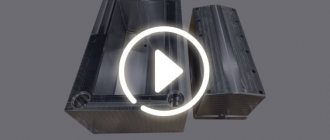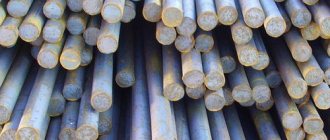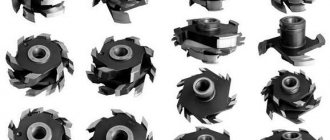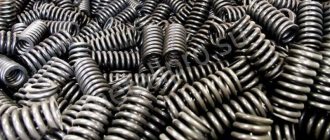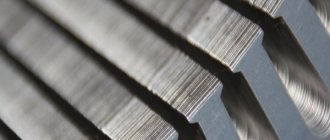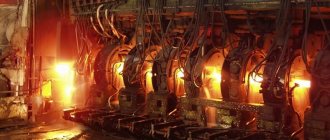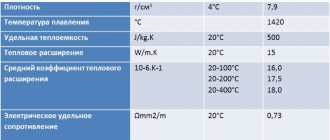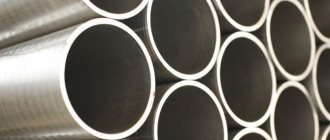Classification and characteristics
This category of steels is divided into 3 main groups:
- die steels for cold deformation of metals;
- for hot deformation of metals;
- resistant to corrosive processes.
In accordance with the purpose, specific requirements are imposed on each of the above groups.
After the final heat treatment, the steels of the first group during the operation of the die should be distinguished by increased strength, wear resistance, and hardness of both the working edge and the sections of the die that absorb maximum torsional and bending loads.
There are the following types of metals that are intended for cold stamping:
- resistant to high pressure, which are highly durable and well resist various deformations;
- having a high chromium content (within 6-32%), characterized by high hardness and wear resistance, which is achieved thanks to chromium carbides;
- used in the manufacture of embossing and heading dies, which are used under conditions of increased shock loads.
In the production of dies of small sizes and simple configurations for cold stamping, carbon steel grades U10, U12, U11, as well as low-alloy KhVG, KhVSG, X, etc. are used as raw materials.
The second group of die steels at high temperatures should maintain increased mechanical characteristics. To obtain the required properties, the material is thermally treated.
Hot-stamp alloys are characterized by increased heat resistance, a high level of hardenability, and low sensitivity to local heating. The material must meet such requirements as: high strength (more than 1000 MPa), heat resistance and sufficient viscosity necessary to maintain the shape of the stamp under prolonged temperature exposure and high mechanical loads.
Tempering and hardening of the material is carried out at 550-680°C. To increase hardness values, chemical-thermal treatment (boridation, nitriding) is used. An additional requirement for this group includes resistance to the formation of various cracks under constant temperature changes (heating, cooling).
To produce hot dies with complex shapes, oil-hardened high-alloy carbon steels 5ХНТ, ШХ15, 4ХМФС, 5ХНМ, etc. are used.
The third group is used to create mold matrices for injection molding of various metals. In addition to the properties of the steels of the previous group, they must be resistant to the influence of aggressive environments (for example, cast aggressive metal alloys or chemically active plastics).
Cold forming steels
⇐ PreviousPage 7 of 24Next ⇒
Cold stamping is one of the main types of OMD.
These include drawing, forming, wrapping, bending, etc. The most commonly used cold stamping operation is drawing.
Drawing is a cold plastic deformation in which a volumetric part of complex shape is obtained from a sheet blank.
The main requirements for steels intended for cold stamping are:
— good stampability, i.e. ability to deform plastically when cold.
— high surface quality after deformation.
These requirements are ensured by the mechanical properties and structure of the steel.
Requirements for mechanical properties include minimum hardness (usually no more than 45HRB) and maximum ductility. The ability to undergo plastic deformation is assessed by relative elongation and the ratio of the yield strength to the ultimate strength. This indicator is called the turnover number. Good formability is observed in steels with a yield number σт/σв = 0.5-0.6 and δ = 33 – 45%.
Structure requirements include:
1.Medium ferrite grain.
2. Fine discharge of granular perlite.
3. Absence of a carbide network of tertiary cementite along the grain boundaries.
4.Lack of banded structure.
5.Lack of texture.
6.Lack of different grain sizes.
The steel must have a medium grain (average grain size 6-8 mm). Fine grain is not desirable, because... causes increased rigidity of the sheet and, consequently, rapid wear of the dies. Large grains are not desirable, because... deteriorates the quality of the surface after stamping. Roughness appears on the surface, which is called orange peel. It is especially undesirable to have different grain sizes in steels for cold stamping. When such steel is deformed, the large grains are stretched first, as they are more ductile, and then small cracks and tears appear in these places, which is an irreparable defect.
Cementite in steels for cold stamping should have a rounded shape, i.e. be spherical. This ensures the best stampability. In such steels, the formation of a cementite network along the grain boundaries is unacceptable, because this leads to a sharp decrease in ductility. Fine sorbitol-like perlite is also undesirable, because this dramatically increases the rigidity and elasticity of the sheet.
The banded structure and rolling texture are also undesirable because cause heterogeneity of deformation in different directions and scallops appear on the stampings (Fig. 13).
A b
Fig. 13. Difference in properties in different directions (a) in the sheet
and scallops after stamping (b)
Most often, carbon steels with a carbon content of 0.05 - 0.2%, Mn ≤ 0.4% and a minimum content of gases N, O2, H2 are used for cold stamping. For example, 05kp, 08kp, 08ps, 08sp, 10, 15, 20, St. 1 - Art. 3.
The main grade of steel for cold stamping is 08kp steel. It has the best ductility and minimal cost. However, the disadvantage of this steel is increased gas saturation. The increased content of gases makes this steel prone to strain aging.
Strain aging is an increase in the yield strength of steel caused by the accumulation of N2 and O2 atoms around dislocations. The creation of such atmospheres of atoms is called cotrell atmospheres
.
Rice. 14. Tensile diagrams for steel prone to deformation
aging (a) and non-aging (b).
They block the movement of a dislocation and require greater force to initiate plastic deformation. After dislocation detachment, the shear stress decreases and plastic deformation is facilitated. As a result, a peak appears on the tensile curve at the yield point (Fig. 14).
The separation of dislocations from atmospheres of impurity atoms occurs unevenly. As a result, the metal volume begins to deform along planes most favorably oriented with respect to the acting load. This preferential deformation manifests itself in the form of the appearance of slip lines on the metal surface. The grid of such lines looks like scratches and reduces the surface quality, which is a defect for parts after cold stamping. To eliminate this defect, preliminary deformation of the metal in rolling rolls with a reduction of 2% is used. It's called training. Small plastic deformation causes the separation of dislocations from the atmospheres of impurity atoms and subsequent stamping no longer causes slip. However, the effect of training lasts from 10 to 12 days.
Table 3
Main steel grades used for cold stamping
| Tensile strength MPA | Relative extension, % | ||
| Brand | Note | ||
| St.2-St3 08kp 08ps, 10kp 15kp 15, 20kp | 340-420 280-390 280-420 300-440 320-460 340-480 350-510 400-550 | 26 — 31 30—34 28—32 28—30 27—29 25—27 24—26 23—24 | Hood groups N, G, VG |
| 08kp 08Fkp 08Yu | 260—330 260—340 | 42 — 44 | NE, OSV SVSV |
The tendency of steel to strain aging can be eliminated by introducing aluminum or vanadium into it during the production process. Small additions of these elements in the amount of 0.02 - 0.05% bind nitrogen atoms into nitrides. As a result, the diffusion of nitrogen atoms is blocked. Such steel is called non-aging, for example 08YU, 08F, 08YUA, 08GSYUT, 08GSYuF.
To ensure high ductility of steel for cold stamping, the main type of heat treatment for it is recrystallization annealing. Steel sheet after cold rolling has increased strength; as a result of hardening, annealing is used to eliminate it at a temperature of 660 - 680ºC. Annealing is used for steel in coils or for bundles of cut sheets. The duration of such annealing is determined by the mass of the roll and is 10-20 hours. In order to obtain an average grain after such annealing, it is necessary that the previous deformation be 30-40%. With small deformations, coarse grains may appear. And with a large degree of deformation, texture formation is possible.
For stamping products requiring increased strength, low-alloy “two-phase steels” are used with a structure consisting of a highly plastic ferrite matrix and a strengthening phase of martensite or bainite in an amount of 20-30%. Such steels are called two-phase ferritic-martensitic (DFMS). To obtain such a structure, alloying elements are added to the steel and preliminary, hardening heat treatment is carried out before stamping. The main alloying elements are Mn - 1.4-2%, Si from 0.5 to 1.5%, Cr - up to 08 - 1%, Mo - up to 0.2-0.4%, as well as small additives Al and W. The amount of carbon in these steels is 0.03-0.06%.
Typical steel grades:
03ХГУ
06ХГСУ
12ХМ
06G2SYU
To create the required steel structure during its production, accelerated cooling is carried out after hot rolling, or the steel is additionally heated and cooled at a temperature above point A1, but below point A3. In essence, such heat treatment is called incomplete hardening. As a result, the structure of such steel consists of 70% ferrite and 30% martensite. Ferrite provides high ductility, good stampability, and martensite provides increased strength. During the stamping process, deformation is concentrated in the ferrite grains, and an increased degree of hardening increases the strength of the finished product. After stamping, the tensile strength of such steel is 1.3–1.5 times higher than the tensile strength of conventional carbon steels. No additional leave is required.
⇐ Previous7Next ⇒
Recommended pages:
Distinctive features
The technological properties that are characteristic of die steels include:
- Low sensitivity to overheating. It is possible to harden with heating in a very wide temperature range;
- Good machinability. Steels have the ability to handle cutting and pressure well in hot and cold conditions;
- Low deformation during heat treatment;
- Good grindability, essential for high quality polished and ground surfaces;
- Good hardenability. It is possible to obtain a high level of uniform hardness, a fine-crystalline uniform structure to a sufficiently large depth;
- Low sensitivity to decarburization during heating, which reduces the hardness of the working metal layer (surface).
History of metal stamping technology
It is believed that stamping originated from forging. Archaeological excavations indicate that since ancient times man has learned to make various flat and three-dimensional products from metal. For example, people made arrowheads using crimp dies.
Full-fledged hot die forging arose in the early 19th century. In Russia, the first products created using processes similar to modern technologies were gun triggers. Back then they used a screw lever press and backing dies.
In 1819, at the Tula arms factory, they mastered single-strand stamping, with which they made a whole range of parts. Then they were straightened and the burrs were cut off. The main role was played by a single-action hammer, and in the second half of the 19th century it was replaced by a steam mechanism. Thanks to this, stamping became widespread and improved.
By the 30s of the 20th century, processes were automated. Aviation, mechanical engineering, automotive and other enterprises have their own workshops for stamping metal parts. Steam presses were used for many years. They were not abandoned even with the invention of the hydraulic installation, which was first introduced in 1861. But gradually hydraulics replaced hammers powered by steam.
Back in the 20th century, production was predominantly serial. Only a few factories used stamping methods to produce large series of metal products. The difficulties were caused by the need to repeatedly reconfigure the equipment.
To date, enterprises have come to the idea of specializing in the manufacture of certain products. Modern technological solutions have simplified the process of retooling tools and equipment. Thanks to this, metal stamping technology has become more economical and simpler while increasing productivity.
Applications of die steel
Die steels are widely used in modern industry. They are often used to make:
- dies for horizontal forging machines;
- large hammer and press inserts;
- measuring equipment;
- typesetting and molding matrices, punches;
- high-precision products;
- production of thread rolling tools;
- knives for cold metal cutting;
- rolls of cold rolling mills;
- molds operating under pressure for casting copper, zinc, aluminum, titanium and other alloys.
Stamping as a type of forging
There are free forging and stamping, which differ in technology and quality of the result.
Can be used for workpieces of any weight and volume. Produced using hammers or presses. The workpieces are placed on the base without fastening and processed with blows of a steam-air or pneumatic hammer. After crimping on one side, the semi-finished product is turned and processing continues until the forging is completely ready. The process on presses is approximately the same. The disadvantage of free forging is the impossibility of obtaining exact dimensions, which results in:
- the need for subsequent processing on metalworking machines;
- a large amount of waste going into chips;
- the need for a wide range of metalworking equipment.
The main difference from free forging is the limitation of the spreading of the metal of the workpiece by a die consisting of two parts: the lower one is fixedly fixed on the anvil, and the upper one moves freely up and down. The resulting products - stampings - are much closer in size to the desired result, compared to forged products. Volumetric stamping allows you to obtain a small-in-weight, geometrically complex product from a sheet.
Thanks to this technology, it is possible:
- produce parts and products of various sizes and configurations with a surface finish that does not require subsequent processing;
- carry out mass production of products with identical geometric parameters;
- ensure high process productivity - most stamping operations are performed on lines with a high level of automation.
Attention! It is impossible to completely abandon free forging in favor of stamping, because making a die is an expensive and complex process that justifies itself in mass production.
Based on the temperature at which the operation is carried out, hot and cold stamping are distinguished.
Stages of stamp manufacturing
A major role in ensuring the required quality of the finished product is played by the design of dies for cold stamping, due to which the part is formed with the required geometric parameters. Working drawings of such working tools installed on stamping presses can be made in both two- and three-dimensional formats. To solve this problem, appropriate knowledge and skills are required.
The development of a drawing and the subsequent production of a stamp used for cold stamping are carried out in several stages:
- drawing up a sketch of the future stamp;
- studying the scheme according to which the material will be cut, checking such a scheme using a special computer program;
- editing the sketch, if necessary;
- final verification of the dimensions of the developed stamp;
- designation of the position and exact dimensions of the holes that will be made on the working surface of the stamp.
When developing dies for cold forming, it is necessary to break the drawing of the finished product into separate parts and carefully study them. After this procedure is completed, the production of stamps is carried out. In this case, it is necessary to pay special attention to the requirements for the parameters of the finished product. For each stage of the cold stamping technological process, a route map is developed, which takes into account both the execution time of individual operations and the characteristics of forgings at individual processing stages.
In such a matter as cold stamping of a metal workpiece, many parameters are important, which, in particular, include the sequence of technological operations, the distribution of material in the cavity of the working tool, the equipment used and processing modes.
The process of manufacturing dies for cold stamping also imposes serious requirements, since the quality of the formed product depends on the accuracy of this tool.
Stamping of parts, in which sheet metal is used as a workpiece, can include a whole list of mechanical operations. Such operations include, but are not limited to, cutting, punching, extruding, bending, cold heading, forming, crimping and drawing. In this case, cutting, punching and a number of other technological operations are classified as separation operations, and cold heading, molding, bending, etc. are classified as shape-changing operations.
Hot metal stamping
Hot stamping of metal makes it possible to process thicker workpieces, since the intermolecular bonds in the hot alloy are much weaker, and it is easier to bend. Before starting the procedure, metal products undergo the same preparatory steps as in the case of cold stamping. But equipment for metal stamping is already significantly different. It consists of two main parts: a furnace and a press. The furnace is used to preheat the workpiece to a red-hot temperature. In this form, the alloy lends itself well to physical impact and there is absolutely no risk of burning it out.
To create optimal conditions inside the furnace, modern machines are equipped with a high-precision automated control system. It only requires setting the initial parameters, which depend on the type of part being processed. The computer will take care of the rest. Presses for hot metal stamping are made from hard, high-alloy steel grades, which undergo additional processing to increase resistance to thermal stress. They must withstand a certain number of technological operations without losing their original characteristics, so it is very important to use the highest quality material for their production.
Hot stamping requires direct human participation in the production process. The workpiece cools quickly under normal conditions, so it must be quickly delivered from the furnace to the metal stamping machine. This is done by a worker who, using blacksmith pliers, transfers the product to the desired place. Working in an environment with constantly high temperatures has a negative impact on the body, so it is necessary to correctly calculate the duration of shifts in order to minimize the harmful effects of the conditions on workers. Automation of the process also faces great difficulties and requires high costs, so it is practically not used anywhere.
No additional equipment is used to cool the parts; they cool naturally. In most cases, no additional processing of parts is required after stamping. The exception is products for the automotive industry that undergo galvanizing. Sometimes when stamping sheet metal it becomes necessary to trim off excess elements. For this purpose, a special machine with a high-precision cutter is used.
Purchase of stamping equipment
Companies that produce equipment for cold and hot metal stamping constantly modify their machines to ensure that they produce high-quality parts and operate for a long time.
Such equipment includes:
- electric presses;
- pneumatic presses;
- hydraulic pressing devices.
Sales are made directly from the websites of manufacturing companies, where various consultation-type conversations are previously held with the client. Most of these companies are engaged in the manufacture of not only standard pressing equipment, but also produce equipment taking into account customer requirements.
Modern hydraulic pressing machines are made of such metal that they can practically create deformations of any material. On the manufacturer’s website, the client is offered a wide range of pressing equipment. To buy equipment for sheet stamping, all you need to do is place your order and make an advance payment.
The conditions for delivery of an order to any region of the Russian Federation also need to be discussed in advance. Companies willingly provide transport services, but for an additional fee. Under an additional agreement, the supplier’s specialists undertake the installation and commissioning of the supplied pressing devices. It is very important not to forget to draw up an agreement for warranty service of the machines, which provides for their free repair in case of failure during the period of the supplier’s warranty.
